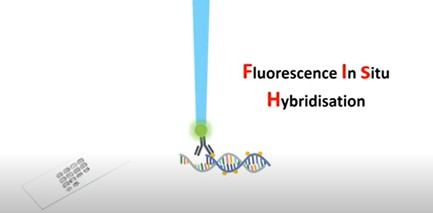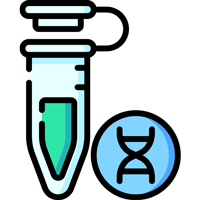FISH Probe Design, Synthesis and Testing Service
- Service Details
- Workflow
- Features
- FAQ
- Explore Other Options
Fluorescence In Situ Hybridization (FISH) is a cornerstone methodology in molecular cytogenetics. By utilizing fluorescently labeled nucleic acid probes that bind specifically to target chromosomal or gene sequences, FISH enables gene localization, copy number analysis, detection of chromosomal structural variations, and identification of pathogenic microorganisms. This technology is widely applied across diverse fields, including tumor diagnosis, genetic disease screening, genomic research, and cell biology studies.
 Fig. 1 Scheme of the principle of the FISH experiment to localize a gene in the nucleus.
Fig. 1 Scheme of the principle of the FISH experiment to localize a gene in the nucleus.
Leveraging years of expertise in FISH technology, Creative Bioarray has launched a fully customized, end-to-end probe development service to address complex target detection challenges in both research and clinical settings. Whether your study involves rare species, low-abundance targets, or multiplex co-localization analysis, we deliver precisely tailored solutions to help overcome experimental bottlenecks.
Service Details
Comprehensive Target Coverage
- Supports gene/chromosomal regions across multiple species, including human, mouse, rat, microorganisms, plants, and more.
- Compatible with DNA, mRNA, miRNA, and lncRNA probe design.
Flexible Labeling Solutions
- Single-color or multiplex probes (up to 4-color simultaneous detection).
- Fluorescent dye options: FITC, Cy3, Cy5, etc., with spectral crosstalk correction protocols.
Rigorous Quality Control
- Specificity Validation: Confirmed via Southern blot, qPCR, or FISH experiments.
- Quality Assurance: HPLC purification, concentration measurement, and labeling efficiency verification.
Service Workflow
Requirement Submission
Clients provide target gene/chromosomal region information and experimental objectives.

Design and Confirmation
Experts evaluate requirements, design candidate probes using bioinformatics analysis, and deliver a feasibility report.

Probe Synthesis
Probes synthesized under strict quality control protocols.

Testing and Optimization
Independent test reports include specificity, sensitivity, and hybridization condition optimization data.

Delivery and Support
Final delivery of probes, test reports, experimental protocols, and post-sale technical support.

Key Features

Custom Probe Development
Tailored probe design for unique experimental needs.

Resource Assurance
Full access to the RP11 BAC library for large-fragment analysis.

Multiplex Probes
Supports multi-target detection with spectral optimization.

Sample Compatibility
Validated for fresh, frozen, or FFPE samples.

Stringent Quality Control
Mass spectrometry, HPLC purity analysis, and hybridization validation ensure reliability.
FAQ
1. What gene information is required for probe design?
Provide the target's NCBI ID, genomic coordinates, or FASTA sequence. For non-model species, reference genome data is required.
2. Do you support multiplex FISH probe design?
Yes, we develop multiplex probes (up to 4 colors) with spectral overlap correction.
3. How is probe specificity ensured?
Specificity is guaranteed through:
- Bioinformatics screening to exclude repetitive sequences;
- Post-synthesis validation via Southern blot or qPCR;
- Negative control testing to eliminate nonspecific hybridization.
4. What cell samples are compatible with your FISH probes?
Our probes are validated for cultured cells, tissue sections, blood cells, bone marrow cells, and more. Special sample types should be specified during ordering for customized optimization.